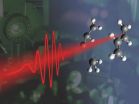(Press-News.org) The study of chromosome changes arisen during species evolution is a current and intriguing topic that evolutionary biology proposes. However, in several groups (for example, molluscs), and chitons in particular, chromosome studies are scarce, with a few species investigated and analyses performed mostly with simple methods.
Only 2,5% of about 900 living species of chitons have been so far karyologically investigated, all of them in the same order (Chitonida). The authors note that the species of suborder Chitonina all have a karyotype of 2n=24 chromosomes, all biarmed, that is metacentric or submetacentric. The species studied by the authors, formerly included in Chitonida, also possesses 2n=24 elements, but many are uniarmed and, therefore, resembling to the chromosome complement of species of the suborder Acanthochitonina. This provides support to recent attribution of the studied sea cradle to the latter suborder.
Furthermore, the comparison among the karyotypes of the suborder Acanthochitonina allows the authors to propose that in this group of chromosome changes mainly occurred by fusion among uniarmed elements. This kind of change is that mainly involved in chromosome animal evolution. The study was published in the open access journal Comparative Cytogenetics.
INFORMATION:
Original source
Petraccioli A, Maio N, Odierna G (2012) Chromosomes of Lepidochitona caprearum (Scacchi, 1836) (Polyplacophora, Acanthochitonina, Tonicellidae) provide insights into Acanthochitonina karyological evolution. Comparative Cytogenetics 6(4): 397. doi: 10.3897/CompCytogen.v6i4.3722
Additional information
Odierma G, Aprea G, Barucca M. Biscotti M, Canapa A, Capriglione T, Olmo E (2008) Karyology of the Antarctic chiton Nuttallochiton mirandus (Thiele, 1906) (Mollusca: Polyplacophora) with some considerations on chromosome evolution in chitons. Chromosome Research 16: 899. doi: 10.1007/s10577-008-1247-1
Posted by Pensoft Publishers.
Advance in chromosomal evolution in sea cradles
2012-12-12
ELSE PRESS RELEASES FROM THIS DATE:
'Smart stethoscope' advance in monitoring treatment of kidney stones
2012-12-12
A new listening device, developed by scientists from the University of Southampton, is being used to monitor the effectiveness of the treatment of kidney stones - saving patients unnecessary repeat therapy and x-ray monitoring.
If kidney stones cannot be dissolved by drugs, the favoured procedure is lithotripsy. Lithotripsy works by focusing thousands of shock waves onto the kidney stones in an effort to break them into pieces small enough to urinate out of the body or be dissolved by drugs.
However, it is difficult to discover exactly when the treatment has succeeded ...
Rice, Texas Children's team creates biocompatible patch to heal infants with birth defects
2012-12-12
A painstaking effort to create a biocompatible patch to heal infant hearts is paying off at Rice University and Texas Children's Hospital.
The proof is in a petri dish in Jeffrey Jacot's lab, where a small slab of gelatinous material beats with the rhythm of a living heart.
Jacot, lead author Seokwon Pok, a postdoctoral researcher at Rice, and their tissue-engineering colleagues have published the results ofyears of effort to produce a material called a bioscaffold that could be sutured into the hearts of infants suffering from birth defects. The scaffold, seeded with ...
Climate modelers see possible warmer, wetter Northeast winters by 2070
2012-12-12
AMHERST, Mass. – A new high-resolution climate study by University of Massachusetts Amherst climate scientists, the first to apply regional climate models to examine likely near-term changes in temperature and precipitation across the Northeast United States, suggests temperatures are going to be significantly warmer in all seasons in the next 30 years, especially in winter. Also, they project that winters will be wetter, with more rain likely than snow.
Writing in the current issue of the Journal of Geophysical Research, Michael Rawlins and Raymond Bradley of the Climate ...
UGA researchers find algal ancestor is key to how deadly pathogens proliferate
2012-12-12
Athens, Ga. – Long ago, when life on Earth was in its infancy, a group of small single-celled algae propelled themselves through the vast prehistoric ocean by beating whip like tails called flagella. It's a relatively unremarkable tale, except that now, more than 800 million years later, these organisms have evolved into parasites that threaten human health, and their algal past in the ocean may be the key to stopping them.
The organisms are called apicomplexa, but people know them better as the parasites that cause malaria and toxoplasmosis, serious diseases that infect ...
Ultra-short laser pulses control chemical processes
2012-12-12
This press release is available in German.
Chemical reactions occur so quickly that it is completely impossible to observe their progress or to control them using conventional methods. However, new developments in electrical engineering and quantum technology enable us to achieve a more exact understanding and improved control of the behaviour of atoms and molecules. At the TU Vienna, scientists have succeeded in influencing the splitting of large molecules with up to ten atoms using ultra-short laser pulses.
The flash of light which splits molecules
Splitting a ...
Older and younger chronic leukemia patients may need different therapy
2012-12-12
People who develop chronic lymphocytic leukemia (CLL) are typically age 65 and older, but participants in CLL clinical trials are usually several years younger;
The age of CLL patients is not usually considered when determining treatment;
This study suggests that older and younger CLL patients require different therapy.
COLUMBUS, Ohio – Doctors should use different therapies when treating older and younger patients with chronic lymphocytic leukemia, according to a new study led by researchers at the Ohio State University Comprehensive Cancer Center – Arthur G. ...
Researchers shed light on the workings of the body's immune response
2012-12-12
Researchers from Queen Mary, University of London have discovered that two proteins which are believed to play a key role in controlling the body's immune response are found in lower levels in T lymphocytes from patients with multiple sclerosis (MS).
The study found that MS patients' T lymphocytes – types of white blood cells which play an important role in the immune system – were defective at producing the proteins and that this was associated with increased levels of molecules which promote inflammation. The findings are reported in the Journal of Immunology¹.
The ...
Can algae-derived oils support large-scale, low-cost biofuels production?
2012-12-12
New Rochelle, NY, December 12, 2012—ExxonMobil and many other energy companies are investing hundreds of millions of dollars to develop transportation biofuels from renewable resources such as the oil or hydrocarbons produced by microalgae. As global supplies of fossil fuels continue to shrink, biofuels derived from algae represent one promising source of low-cost, scalable renewable energy. The feasibility and economic projections for large-scale biofuels production from microalgae are examined in a Review article and accompanying Commentary published in Disruptive Science ...
Novel test identifies patients most likely to benefit from ALK inhibition therapy
2012-12-12
Philadelphia, PA, December 12, 2012 – Approximately one in 20 patients with non-small cell lung carcinoma (NSCLC) has chromosomal aberrations targeting the anaplastic lymphoma kinase (ALK) gene. This has considerable implications for treatment because these patients are highly responsive to ALK-specific kinase inhibitors such as crizotinib. However, current diagnostic tests have limitations. Researchers have now developed and tested a promising new method for screening ALK fusions in NSCLC. This new diagnostic assay offers a cost-effective and easy-to-perform alternative ...
Frog-in-bucket-of-milk folklore leads to potential new antibiotics
2012-12-12
Following up on an ancient Russian way of keeping milk from going sour — by putting a frog in the bucket of milk — scientists have identified a wealth of new antibiotic substances in the skin of the Russian Brown frog. The study appears in ACS' Journal of Proteome Research.
A. T. Lebedev and colleagues explain that amphibians secrete antimicrobial substances called peptides through their skin. These compounds make up the majority of their skin secretions and act as a first line of defense against bacteria and other microorganisms that thrive in the wet places frogs, toads, ...



